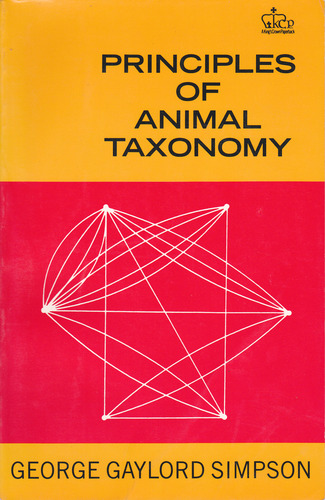Principles of animal taxonomy ebook
Par lancaster roland le vendredi, octobre 2 2015, 21:26 - Lien permanent
Principles of animal taxonomy by George Gaylord Simpson


Principles of animal taxonomy George Gaylord Simpson ebook
Publisher: Columbia University Press
Page: 131
Format: djvu
ISBN: 023109650X, 9780231096508
According to Simpson (“Principles of animal taxonomy”), a taxonomy is a “classification, including bases, principles, procedures and rules”. The end result was a classification of existing 'data assets' into three main types of animals (although I would later argue the animals were really different zoos.) From this I During the UX design a fundamental principle was data integrity. Comparison of exotic horn types The heroic age of biological taxonomy is long over, but anatomy as an explanatory principle is still able to take over with a special convincing force any wonderful being from the world of legends to our one. This course begins with an overview of key concepts in zoology as students examine the characteristics of the animal cell and discuss heredity and issues of evolution, including natural selection. From microscopic investigation to the basics of veterinary medicine, Zoology covers principles of comparative animal anatomy, physiology, and genetics. Introduction Biology as a science, put the various organisms as its object of study. Classification has two meanings in English: the process by which things are grouped into classes by shared characters and the arrangement of those classes. By method authors mean an arrangement of minerals, plants, and animals according to the principles of logical division. We shouldn't smuggle taxonomic principles into everyday language to make a political argument. Andrew Pawley (Aukland, 1991), 137-47; Brent Berlin, Ethnobiological Classification: Principles of Categorization of Plants and Animals in Traditional Societies (Princeton, 1992); Douglas Medin and Scott Atran, eds. They then turn to taxonomy, as they study increasingly complex types of animals. Taxonomy is international -- everywhere, we recognize that humans are hominoids. French, German, Russian, and other languages do not have to accord with English ways of splitting up animals. Each recently discovered new animal or prodigious being became understandable and inserted in the common system for once as soon as its anatomy was described and, first of all, depicted. English words do not need to be monophyletic. Nomenclature and Classification, Principles of (Insects). This method of classification has changed over time to reflect and accommodate current thinking in science, but primarily the principle has remained unchanged, grouping animals based on shared characteristics.